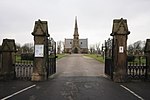St Mark's Church, Blackpool
Church of England church buildings in LancashireChurches in Blackpool
The Parish Church of St. Mark, Layton, Lancashire, England was built in 1927. The building is home to a Church of England Christian community. St.Mark's is a young church compared to many other churches, but has close links with local history because Layton Village was mentioned in the Norman Era 1066-1154 AD.
Excerpt from the Wikipedia article St Mark's Church, Blackpool (License: CC BY-SA 3.0, Authors).St Mark's Church, Blackpool
Westcliffe Drive,
Geographical coordinates (GPS) Address External links Nearby Places Show on map
Geographical coordinates (GPS)
| Latitude | Longitude |
|---|---|
| N 53.8311 ° | E -3.0310388888889 ° |
Address
St Mark's
Westcliffe Drive
FY3 7HR , Hoohill
England, United Kingdom
Open on Google Maps





